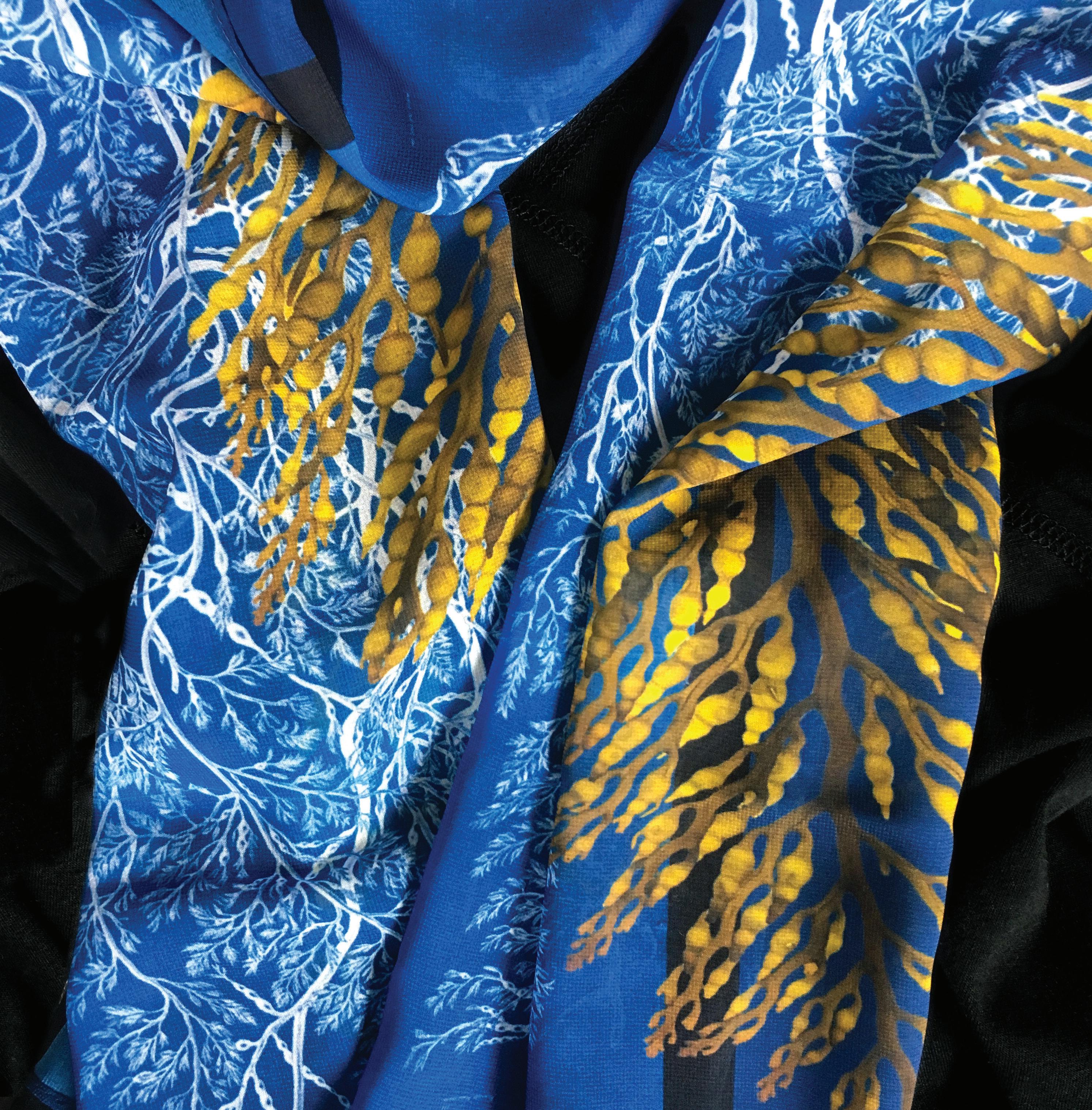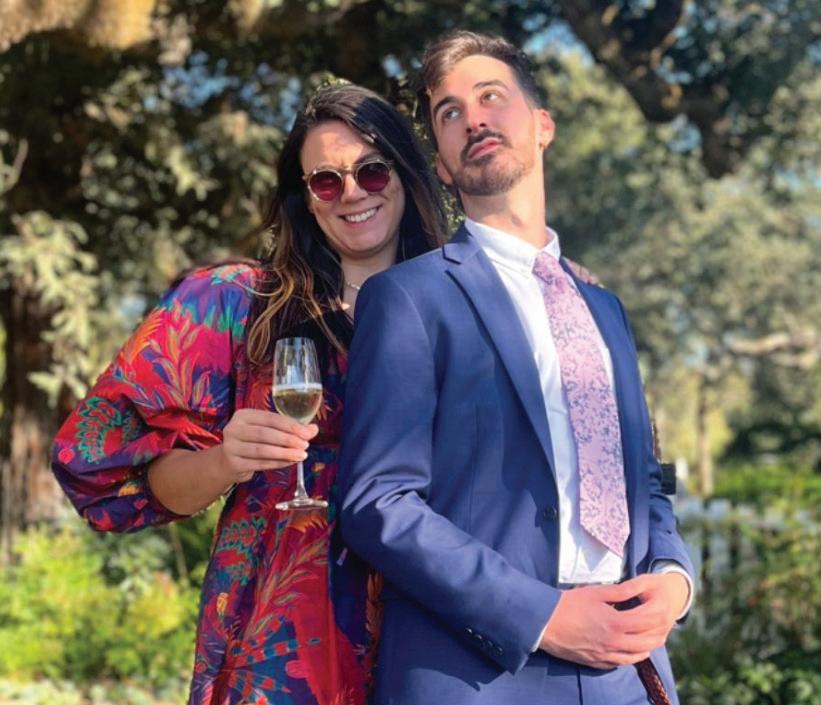
7 minute read
Wearable Art Arrives in the East Bay
Makinga Splash Wearable art arrives in the East Bay
BY Lou Fancher
Among the many rewards and luxurious pleasures of investing and dressing in wearable art is the possibility of draping the ocean around one’s neck—while simultaneously protecting its invaluable ecosystem and tiny treasures. Or literally, metaphorically and perhaps politically, lighting up a social gathering with an illuminated handbag that advocates, in its message, equal pay for all. Alternatively, an outfit might— without shouting rage, but by means of powerful words and imagery— establish unequivocal support for social justice, nonprofit arts organizations, preservation of our natural world and the protection of wildlife. In extended forms, wearable art brought into homes will “dress” and invigorate tables, beds, walls, counters, doors and any other surface or domestic space found in rooms or backyards.
Above all, supreme flexibility allows wearable art to fit the occasion for which it is worn. Notable wearableart possibilities popped into visibility during recent visits to physical and online museum stores at Berkeley Art Museum and Pacific Film Archive and the Oakland Museum of California, and during a centerpiece interview with Bay Area photographer, author and designer Josie Iselin.
The wearable oceanic art arrives in a line of sublime scarves, courtesy of Iselin, whose commitment to welldesigned illustrated books that combine art and science springs forth also in shower curtains and a prototype for neckties currently in development. As a photographer and author, Iselin works in her studio, Loving Blind Productions, to produce the fine-art, limited-edition prints and award-winning books that include her newest book, The Curious World of Seaweed (Heyday Books, 2019). Curious World features 16 narratives and images of iconic West Coast seaweeds and kelps. Her artwork, mostly consisting of large-scale prints, is displayed in galleries, museums and public spaces. Iselin has a bachelor’s in visual and environmental studies from Harvard and a master’s in fine arts from San Francisco State University, and teaches at SFSU’s School of Design.
In a conversation about wearable art, and the scarves specifically, Iselin says, “I straddle so many worlds that I simplify it, and I think of myself primarily as a designer. People come »
SPLASH
Stephanocystis Blue & Gold.

»to know my work through books and artwork. They buy the scarves because they love them. The bonus is that they then learn about my environmental activism and activities. I think people like supporting an artist who is committed to enhancing our waters and oceans. That’s part of the attraction.”
This fall, people are attracted to the color palettes and proportions of Stephanocystis / Blue & Gold and Seaweed & Seagrapes / Turquoise & Rose. The two scarves’ long, skinny 14-by-72-inch dimensions and organic, border-breaking seaweed portraits set against well-chosen contrasting backgrounds are created using premium poly-chiffon and made locally in San Francisco. Hand or machine washable, dried flat and ironed with a cool iron, they are easy-care and impressively durable. “One of my quandaries about making products other than books, which have longevity, is that I’m an advocate for ocean health,” Iselin says. “I’m caught in an internal conflict about producing more stuff. The wearable art I make must have a long life to them. I have scarves I’ve worn daily for six years and a shower curtain up for five years— and all look as new as the day they were first worn or put up.”
Iselin draws from the endpapers of her books to source imagery for the shower curtains. “I was in the shower and thinking about endpapers and thought, ‘What better than a shower curtain to have these patterns on?’” she says. “With the light and transparency of a shower curtain in mind, I found a fabricator in South San Francisco, DPI, who could embed my images right into the fabric. It’s not silk-screened on top. Dye sublimation printing means it’s sublimated into the molecules of the material. You get vibrant color, extreme durability and transparency. You can throw everything I make into a machine with hot water … but use cold water as it’s more environmentally, ecologically sound.”
The Microcladia Orange shower curtain is a standout. Fabricated in polyester ripstop with orange tones from reddish to pumpkin to soft peach, it can be used with or without a liner. Microcladia is a lacy, fantastically circuitous seaweed, found nearly everywhere in the Bay Area, according to Iselin. “This image is a scan of an old specimen, probably over 100 years old, pressed onto herberium paper like a specimen,” she says. “My camera can photograph at a high resolution, so the images work in a book—but also at the scale of a 60-by-72-inch shower curtain.” Iselin says the delicacy and nuance of the color and repetition and flow in undulating seaweed that curls only in one direction creates spirals with geometry and detail that speaks to the wonders of the ocean. “It brings to mind the flowing, wonderfulness of the ocean.”
During the pandemic, Iselin’s curtain fabricator largely shut down and is only now slowly ramping back into operation. Materials, shipping and everything else involved in »
DRESSED UP The gentleman of this smartly dressed couple boasts a Pink Seaweed Tie.

TOPS Seaglass Teal on a Blacktop.
»producing the scarves and curtains has become more expensive, which means she often works on-demand as orders arrive. “Fortunately, it takes only a couple of weeks for a shower curtain, because they’re made locally,” she says. “I could make them cheaper in China, but my conversations with the fabricator, the ability to preserve the quality, the relationships with local makers and the swifter delivery would be lost. These benefits have to remain, because it’s hard to make money off of wearable art unless you are constantly on Instagram. I do these scarves and curtains to make clients happy, not because I’m invested in selling thousands of scarves.”
When people suggest she branch into seaweed-inspired blouses, jewelry, linens or wallpaper, Iselin says, full-stop, “I don’t have the bandwidth to make sure it’s made well, that images are transferred at high quality. I’m too busy! But I do have leftover ripstop fabric from the curtains that would make great handbags, because it’s sturdy.”
Asked about wearable art she herself wears and, in particular, about the gemlike quality of the Talk About Sea Glass / Teal scarf, Iselin says she aims for simplicity when it comes to fashion. “I say there’s a little bit of the beach in these scarves,” she says. “The sea glass in the Talk About scarf breaks across the black border, and that makes it fun. It goes great with anything. It jazzes up the simplest top. I don’t spend a lot of money on clothes. I throw on a scarf and feel fabulous.”
Feeling fabulous is also possible when sporting Oakland-based artist Michele Pred’s wearable-art items found in the BAMPFA store and presented in conjunction with the “New Time: Art and Feminisms in the 21st Century” exhibition. For biggest splash—but please stay safe and don’t immerse wired items in water—there is the high-end Power of the Purse Equal Pay, a vintage creation with an electroluminescent wire. The Art of Equal Pay line extends also into limitededition Equal Pay Masks, Equal Pay Sash and Equal Pay All Shirts, and neon lighting signage perfect for a wall or window.
If hot pink is not the right tone, a softer shade shows up at BAMPFA in Graf Lantz’s flower-shaped felt trivets suitable for table dressing, or go with bold primary and earth-tone colors and set a breakfast scene with Hans Hofmann morning coffee mugs and looks-like-wood-but-isn’t S’well water bottles. Scarves by local printmaker Rigel Stuhmiller come in all shades and, like Iselin’s scarves, are easily added to a monochrome outfit for a zip of color. Marisa Mason’s metal jewelry must never be hidden beneath a scarf, but makes a spectacular “reveal” and talking piece at a holiday gathering. Once removed, a scarf can be tucked into a black or tan New Time tote bag featuring the work “Stigmata,” by Linda Stark, in which the word “feminist” is emblazoned in an abstract image of the palm of a human hand.
At the OMCA store there is more emphasis on “doables”—such as books and games—than on wearables, but even so, in the Fredrika Newton and OwlNWood collection, a Love is Power hoodie and an All Power to the People shirt for the Black Power exhibition are must-haves. Into T-shirts? Pick up a Motherboard T-shirt with art by Madow Futur, presented as part of the museum’s “Voyage into Afrofuturism” exhibition. The hoodies and Ts move in harmony with a pair of ceramic Heath button earrings set into sterling-silver settings by artist Tzipora Hoynik. Created in conjunction with the “Edith Heath: A Life in Clay” exhibition, the collection’s circular shapes are filled with planetary wonders resembling starry night skies, exploding asteroids, abstract four-leaf clovers and more.
Those tapping into wearable art for the first time or merely searching for new frontiers should check this selection out. Whether wrapping the ocean around their neck, picking up a purse or handbag, or donning a T or hoodie that supports the right cause, they’ll be dressed to launch their own journey as they explore more of the East Bay’s abundant shops, galleries, art collectives and boutiques for their next wearable art fashion statement. ❤








